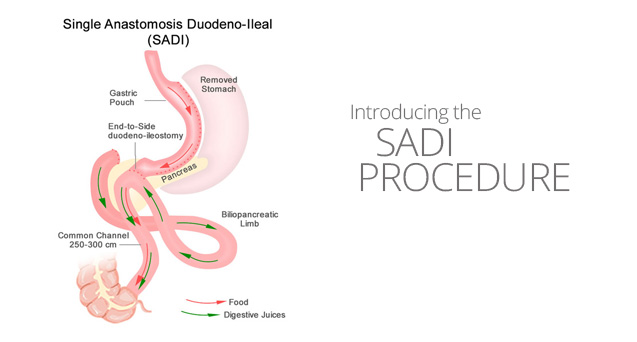Is the SADI procedure an option for you?
The single-anastomosis duodenal switch (SADI) procedure has emerged as a viable surgical option for patients who have experienced a failed or poor outcome after sleeve gastrectomy.
Sleeve gastrectomy has become the operation of choice for many patients and surgeons but it has some limitations and some patients may experience insufficient weight loss or weight regain after the procedure. In such cases, the SADI procedure can offer a potential solution.
The SADI procedure combines aspects of both restrictive and malabsorptive surgeries, making it a powerful tool in treating morbid obesity. It involves creating a single anastomosis between the duodenum (the first part of the intestine after the stomach) and the ileum. This allows food to bypass a length of the small intestine and results in reduced absorption of calories and nutrients, leading to significant weight loss.
When a patient experiences inadequate weight loss or weight regain after a sleeve gastrectomy, several factors may contribute to these outcomes. These can include the dilation of the sleeve over time, the restoration of the stomach’s capacity, and a decrease in the restrictive effect of the surgery. In such cases, the SADI procedure can address these issues by enhancing the malabsorptive component and providing a more powerful metabolic effect.
The SADI procedure offers several advantages for patients who have experienced a poor outcome after a sleeve gastrectomy. First, it allows for a greater degree of weight loss compared to simply a revisional sleeve gastrectomy which redoes the original operation with the same risk of poor outcome or of weight regain.
By increasing the malabsorptive component of the surgery, a SADI provides a more substantial metabolic effect, resulting in enhanced weight loss and resolution of comorbidities. Moreover, at Blackrock WeightCare the SADI procedure is performed using a robotic surgery, which reduces surgical risks by improving the accuracy of surgery and improves patient recovery. SADI is therefore an appealing option for patients seeking a revisional procedure after a failed sleeve gastrectomy. It is important to note that the decision to undergo a SADI procedure after a failed sleeve gastrectomy should be carefully considered and individualized for each patient. A thorough evaluation of the patient’s medical history, current weight, comorbidities, and overall health should be conducted by a multidisciplinary team of healthcare professionals, including bariatric surgeons,
dieticians, and psychologists.
Additionally, postoperative follow-up and long-term management play a crucial role in the success of the SADI procedure. Patients should adhere to a strict dietary plan, engage in regular physical activity, and attend regular check-ups to monitor their progress and address any potential complications. Ongoing support through Blackrock WeightCare’s Aftercare Program provides valuable guidance and motivation throughout the weight loss journey.
In conclusion, the SADI procedure offers a valuable option for patients who have experienced inadequate weight loss or weight regain after a sleeve gastrectomy. It provides a powerful metabolic effect and enhances weight loss outcomes. However, careful patient selection, thorough evaluation, and long-term follow-up are essential to ensure the success of the procedure. With appropriate patient selection and comprehensive postoperative care, the SADI procedure can be an effective tool in achieving sustainable weight loss and improving the health of patients who have experienced a failed sleeve gastrectomy.
Contact us today for a consultation via our locations page.



